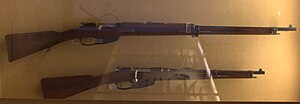Mannlicher 1893
| Romanian repeating rifle model 1893 | |
|---|---|

Rifle and carbine variants.
|
|
| Type | Bolt-action rifle |
| Place of origin |
|
| Service history | |
| In service | 1893–1945 |
| Used by |
Kingdom of Romania Kingdom of Portugal Austria-Hungary Kingdom of Yugoslavia Czechoslovakia Nazi Germany |
| Wars |
Second Balkan War World War I Hungarian–Romanian War World War II |
| Production history | |
| Designer | Otto Schönauer, Ferdinand Mannlicher |
| Designed | 1892 |
| Manufacturer | Steyr |
| Produced | 1893–1914 |
| No. built | 195,000 |
| Variants | M1893 Carbine |
| Specifications | |
| Weight | 4.06 kg (9.0 lb) |
| Length | 122.7 cm (48.3 in) |
| Barrel length | 72.5 cm (28.5 in) |
|
|
|
| Cartridge |
6.5×53mmR 8×50mmR Mannlicher .22 Long Rifle (1946 trainers) |
| Action | Turning bolt-action |
| Muzzle velocity | 731 metres per second (2,400 ft/s) |
| Maximum firing range | 2,100 metres (2,300 yd) |
| Feed system | 5-round en bloc clip, integral box magazine |
The Mannlicher M1893 (or M93) is a bolt-action rifle that was the standard service rifle of the Kingdom of Romania from 1893 to 1938. The rifle (and its 1892 predecessor) were the first repeating rifles to be widely issued in the Romanian military.
Around the year 1890 the Romanian military started its search for a small bore, smokeless powder firearm to replace the breech-loading single-shot Peabody–Martini–Henry M1879. They turned to the nearby Österreichische Waffenfabriksgesellschaft in Steyr, Austria-Hungary where Otto Schönauer was modifing the German Gewehr 1888 rifle. After Ferdinand Mannlicher modified his en-bloc clip feeding system, to allow it to be fed into the rifle regardless of whether the clip was turned up or down, the Model 1892 rifle was ready for testing by the Romanian Army. After some minor improvements, the final variant, the M1893, chambered for the 6.5x53R round, was put into production. Unlike the Austrian-issue Mannlicher M1895 straight-pull bolt-action rifle, the Romanian rifle had a conventional turn-bolt.
The rifle's adoption caused some controversy, as despite the weapon's approval by King Carol I, General Budișteanu[spelling?] derided the Austrian rifle as un baston ("a walking stick"), and the rifle's bore, smaller than the usual Mannlicher product, caused difficulties in finding compatible gunpowder.
A carbine variant was also introduced, it was 98 centimetres (39 in) long and featured a bent bolt handle. It was used by cavalry and artillery units.
...
Wikipedia
